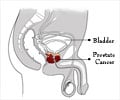Robotic surgery could finally prove to be an answer for the prayers of millions of men suffering from the disease. Surgical treatment of prostate cancer with robotic arms promises sooner recovery
Robotic surgery could finally prove to be an answer for the prayers of millions of men suffering from the disease. Surgical treatment of prostate cancer with robotic arms promises sooner recovery, less pain, scarring and a reduction in the post-operative complications.
Prostate cancer is the second leading cause of death among American men. The disease is however less prevalent in Asian men. It is estimated that one in six males will develop the disease during his lifetime. Scientists have been working actively towards developing new treatment options to help combat this threatening disease.Radical prostatectomy, external beam radiation therapy, brachythearpy and cryosurgery are some of the treatment options available in the current clinical scenario. Erectile dysfunction and Urinary incontinence are the most feared complication associated with radical prostatectomy. With the parallel development taking place in the arena of science and technology, the day is not far before robotic surgery would be included in the above list.
Robotic-assisted laproscopic prostatectomy represents one of the most innovative treatments, minimally invasive, high-tech treatment, that is gaining importance. The University of Pennsylvania Health System is currently one of only a handful of facilities across the country offering this form of treatment that is based at Penn Presbyterian Medical Center.
The robotic surgery is found to confer a superior advantage to both the patient and the surgeon not only in terms of preserving continence and potency but also in reducing minute tremors of the human hand, thereby providing steadiness.
Furthermore, the robot’s camera also provides a three-dimensional, stereoscopic image of the body’s interior, as opposed to a two-dimensional image on a flat screen. This improved perspective enables depth perception that sharpens the visualization of the prostate and the network of nerves and tissue surrounding it.
Robotic technology also deserves special credit in the post surgical phase marked by a speedy recovery and reduced hospital stay. The surgery being minimally invasive eliminates the need for larger incisions, thereby ensuring less pain and scarring and diminished blood loss.
Advertisement

![Prostate Specific Antigen [PSA] Prostate Specific Antigen [PSA]](https://www.medindia.net/images/common/patientinfo/120_100/prostate-specific-antigen.jpg)






